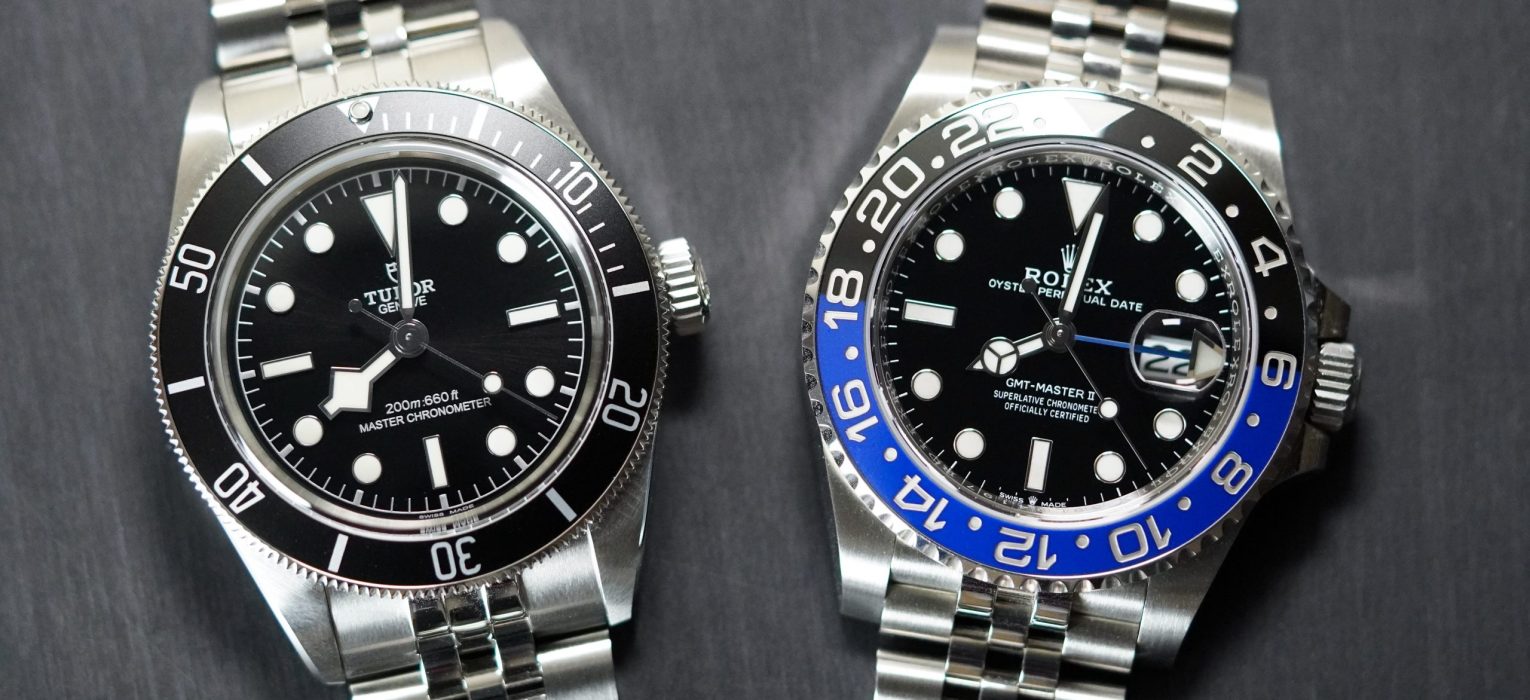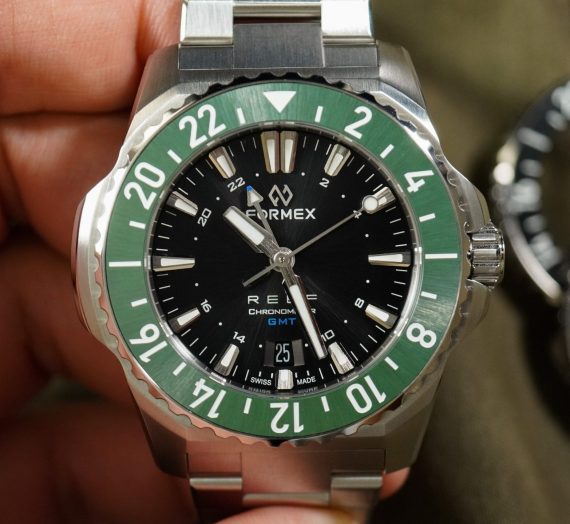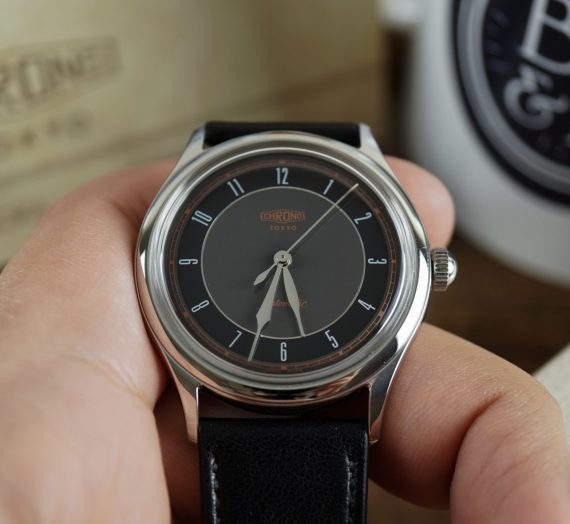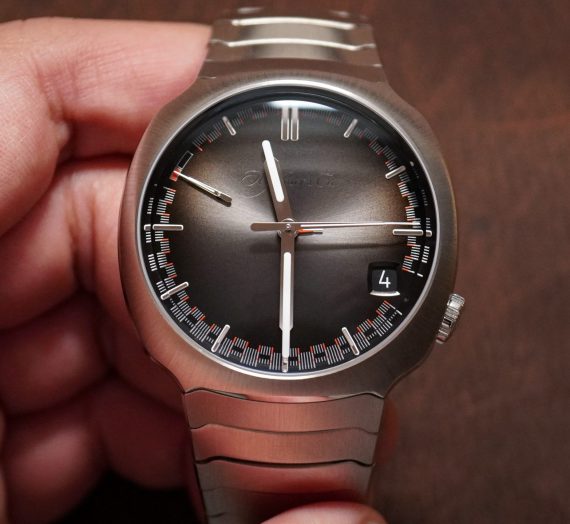Disclaimer: this video/review was not sponsored by Tudor, Rolex or any other entity.
Video
Thoughts
In my previous review of the Tudor Black Bay 41 ‘Monochrome’, I did my best to highlight all the interesting aspects of the watch, addressing common queries about its thickness and how it fits on the wrist. Given the inextricable link between Tudor and Rolex, it seems fitting to compare the Tudor Black Bay 41 ‘Monochrome’, equipped with a ‘Tu-bilee’ bracelet, to a Rolex watch like the jubilee bracelet-clad Rolex GMT Master II ‘Batgirl’. This comparison not only highlights the distinct paths these sister brands are taking but also sheds light on Tudor’s evolution as a brand that some argue is becoming what Rolex once was – an accessible, robust tool watch manufacturer. I will clarify that by accessible I mean a product that you can actually buy once you’ve done the hard part of saving the money to buy it. In no way do I imply this is an affordable watch, considering all the fantastic and well built watches that exist for a fraction of the price of a Tudor.
As Rolex increasingly positions itself as a luxury and high-jewelry brand – evidenced by their expansion of precious metal watches (Lemans Daytona), artistic (Guilloche Dial 1908) and trendy designs (Oyster Perpetual Celebrations, Datejust Jigsaw), and even open casebacks (Rolex 1908, Platinum Daytona) – it seems intent on capturing market share from the haute horology market, traditionally dominated by brands like Vacheron Constantin, Audemars Piguet, and Patek Philippe. As a brand, I don’t believe they need to make these moves, considering the fact that they are the world’s greatest watchbrand with staggering sales figures and an incredible annual throughput. They want to make this their new direction. Perhaps they find their previous ethos of building robust tool watches to be limiting their abilities, or perhaps the Rolex sports watches of today have reached the ultimate form for a functional mechanical sports watch, leaving not much room for product growth.
On the other hand, Tudor has been making significant strides over the past decade, rapidly establishing a strong presence in the watch market with innovative designs and engineering advancements. From utilizing ETA2824 movements to embracing in-house (Kenissi) manufactured movements with METAS Master Chronometer certification, Tudor is not shy about taking risks and is not afraid to operate at a faster pace of product evolution. This is evident in their adventurous releases like the Tudor North Flag, Tudor P01, Tudor Royale, and Tudor FXD, and their use of diverse materials such as gold, bronze, titanium, silver, ceramic, and forged carbon. Tudor is not averse to trying the latest technologies in watch components either, such as their use of ceramic fused luminous blocks on the Tudor Pelagos 39 and the Tudor Black Bay Pro.
That said, I think both brands have much to offer to the watch enthusiast, but it would be unfair to say that Rolex is an enthusiast brand given the tactics that often surround the purchase of a Rolex watch from an authorized dealer. And while I understand that Rolex insulates themselves from the mechanics of retail, the entire process is designed to be not in favor of the casual watch enthusiast, unless of course you view these items as monetary assets, in which case their behavior becomes more palatable.
With this context, let’s explore how the Tudor Black Bay 41 ‘Monochrome’ compares to the Rolex GMT Master II ‘Batgirl’, one of my favorite modern Rolex watches. Let’s go!
Case
The design DNA of the Monochrome and the Batgirl share notable similarities, which is expected given the shared heritage and vision of their founder, Hans Wilsdorf. Both models exhibit a family resemblance, tailored to different segments of the watch market. The Batgirl measures 40mm in diameter both at the bezel and the case, showcasing a compact design as the case tapers slightly under the bezel to about 39mm for easy operation. In contrast, the Monochrome features a slightly larger 41mm diameter at the bezel and 40mm at the case, indicating a subtle bezel protrusion beyond the case. The Batgirl’s lug to lug width is 47mm, extending to 49.5mm when you include the end links, while the Tudor spans a similar 49.5mm lug to lug, reducing to about 48mm from end link to end link. This results in almost identical top view silhouettes for both watches.


In terms of thickness, the Batgirl is approximately 11.5mm, with a notable part of this height attributed to the bezel, while the Tudor is thicker at about 13.25mm, with some of that height tucked into the case-back similar to modern Rolex Submariners (closer perhaps to the maxi-case 116610 than the current 126610). The Tudor’s design efforts to slim down its profile include a subtle curvature at the lugs in an attempt to give it a more contoured fit against the wrist, compared to the Batgirl’s flatter approach.
Both models feature easy-to-operate, signed screw-down crowns – 6mm for the Rolex and slightly larger at 6.5mm for the Tudor. One significant difference is in the choice of bezels and bezel inserts; Rolex opts for a more durable and scratch-resistant ceramic, while Tudor uses aluminum, which I actually find more appealing of late, for its ability to develop character over time through wear and patina. Both inserts feature a luminous marker at the 12 o’clock position. The GMT Master II has a bi-directional 24 click bezel, and the Rolex Submariner has a uni-directional 120 click bezel, whereas the Monochrome features a 60 click unidirectional dive bezel. Between 120 and 60, I tend to find 60 clicks more appealing, specially when the bezel action is loud and snappy like the Tudor.
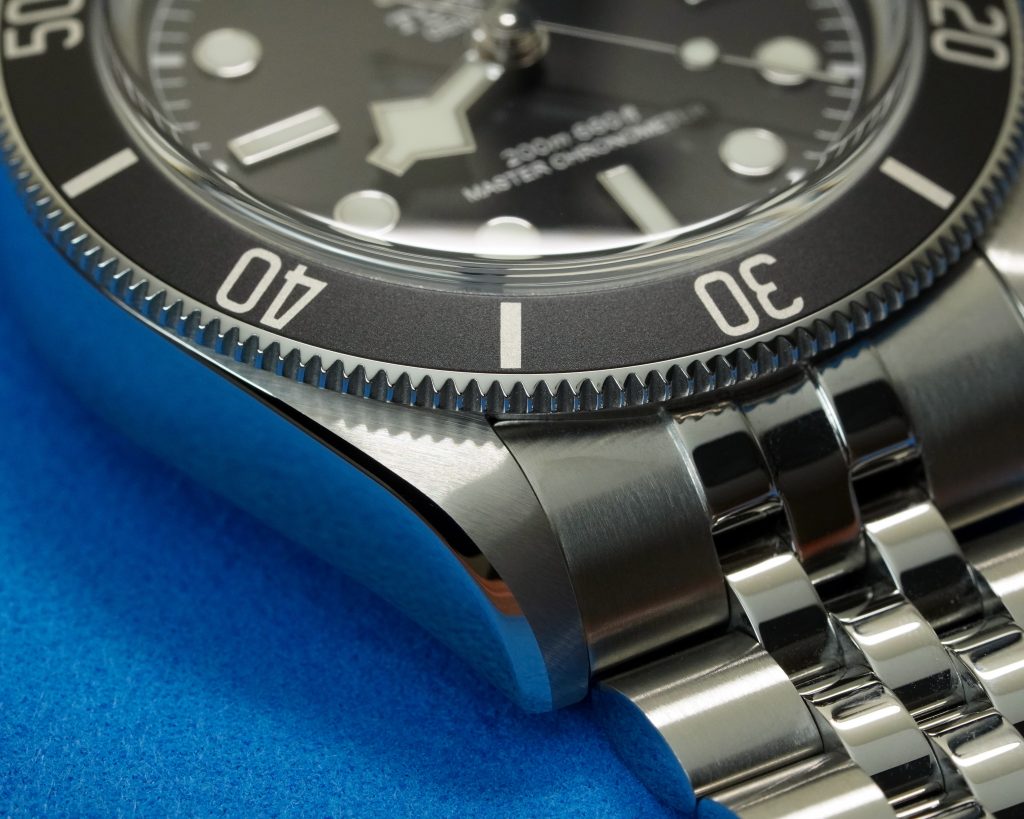

Water resistance also varies, with the Tudor rated for up to 200m, whereas the Rolex has a 100m rating. However, when it comes to material finish, the Rolex’s use of 904L steel offers a more radiant polish and superior brushing quality compared to the Tudor’s, which, while finely crafted with polished bevels and sharp transitions along the case, does not quite match the Rolex overall. The brushed finishing on top of the lugs of the Tudor is a bit patchy in places, whereas the Rolex is uniform throughout, with a perfect transition into the brushed finishing of the bracelet.
Dial
Both brands exhibit a strong adherence to their design DNA, which is both iconic and time-tested. Tudor’s dials maintain a consistent design across their Black Bay line, reinforcing their timeless appeal. Similarly, Rolex’s sports watches – ranging from the Submariner, Sea Dweller, Deepsea, Explorer II to the GMT Master II – share common dial layouts that are integral to the brand’s identity. The Batgirl features a slightly angled rehaut with the brand’s name repetitively engraved, a design choice I find a bit overstated compared to Tudor’s simpler, vertical rehaut with a brushed finish. While Rolex’s approach may appeal to some for its distinctiveness, I personally favor the cleaner, more understated style of the Tudor.
Dial textures differ significantly between the two, with the Batgirl sporting a milky black enamel-esque base that enhances legibility through stark contrasts, and the Tudor showcasing a dynamic black sunburst texture that plays beautifully with light taking on varying monochromatic appearances based on lighting. Both watches have printed minute tracks that are easy to read, though Tudor’s is clearer.
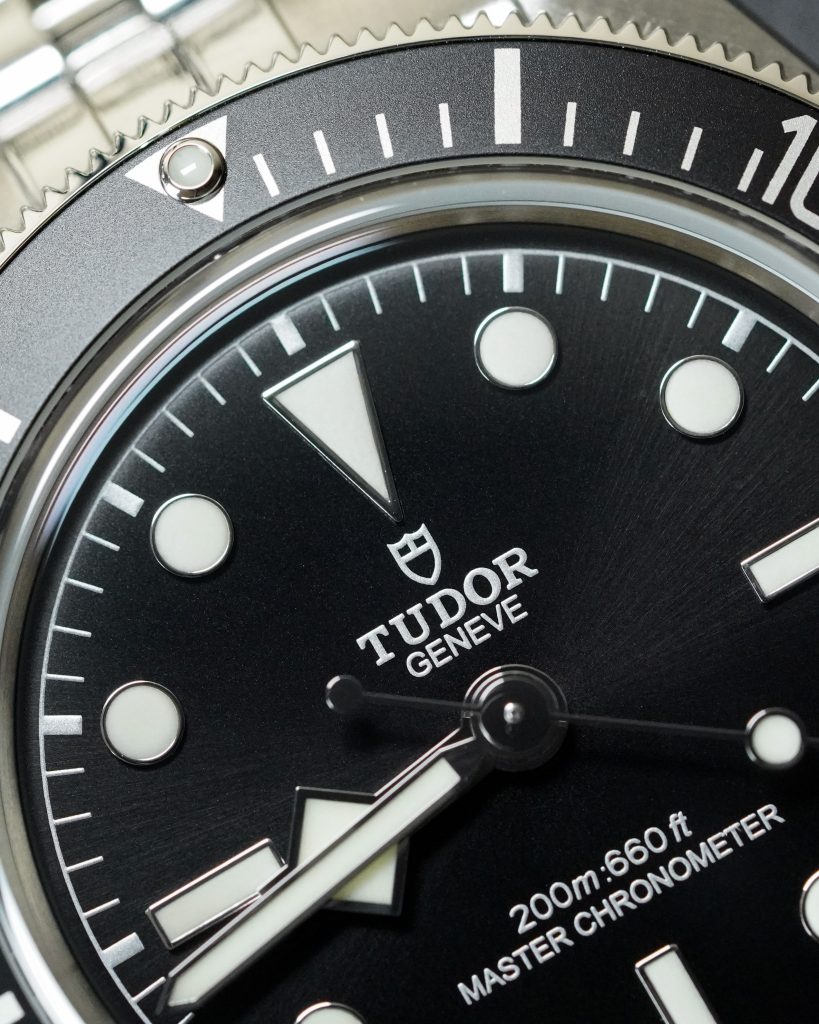

Index designs on both are quite similar, employing a mix of geometric shapes that are typical to both brands. Rolex opts for white gold markers filled with Chromalight, whereas Tudor uses rhodium-plated steel filled with Super LumiNova. Rolex adds a date feature at 3 o’clock with a magnifying cyclops, though the print quality on the date wheel is somewhat lacking, with visible blotting on the numbers.
Both brands display their logos and names below the 12 o’clock index, with additional text above the 6 o’clock index, in comparable print quality, neither standing out as superior. Hand designs are familiar yet distinct, with Rolex featuring the classic Mercedes style and Tudor the recognizable Snowflake pattern. Their minute and second hands are nearly identical in design. Once again Rolex uses white gold indices whereas Tudor opts for the more budget conscious rhodium plated steel option. Additionally the Rolex features a triangle tipped GMT hand painted in blue.
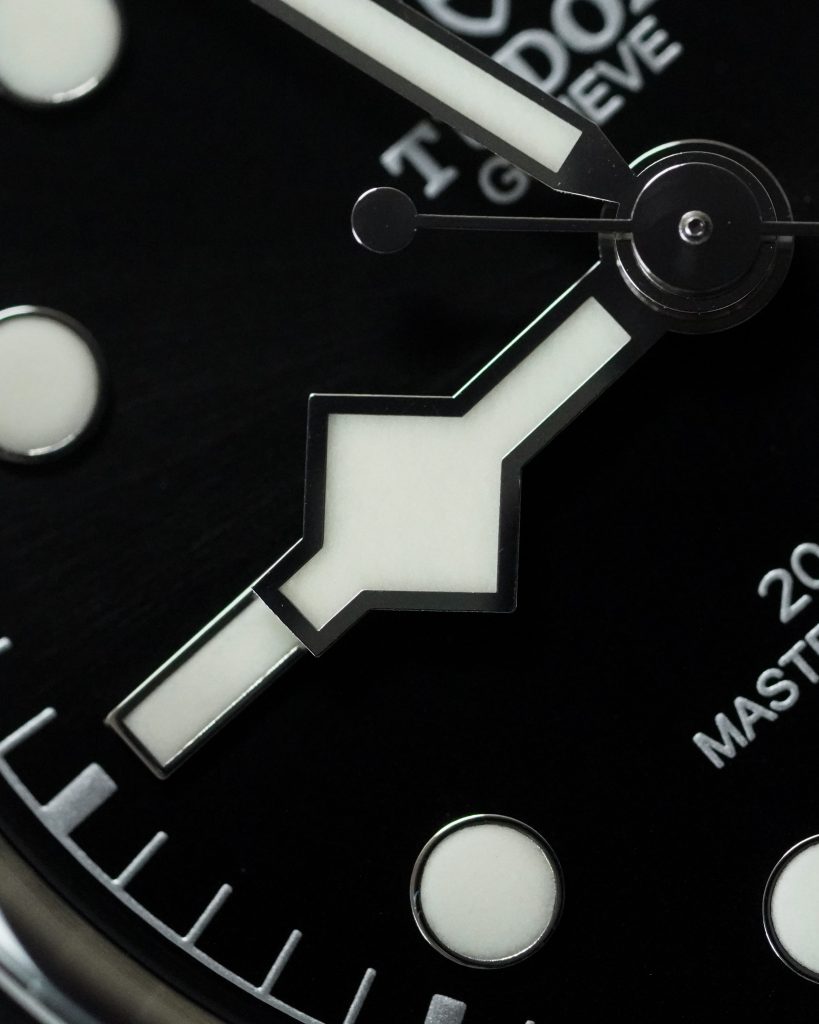

In terms of overall dial finish, both watches show reasonable attention to detail, though not without minor flaws like stray paint and dust, slightly more pronounced on the Tudor. Ultimately, neither dial pushes the boundaries of extraordinary dial craftsmanship; instead, they fulfill their roles as functional, reliable tool watches, prioritizing readability and robust design over decorative complexity.
Lume
In my review of luminous materials used by Tudor and Rolex, it’s worth noting that Rolex utilizes an in-house luminous compound known as Chromalight, which emits a distinctive blue glow. Tudor, while not explicitly detailing their luminous material, likely uses a variant of Super LumiNova. Interestingly, Tudor has been exploring innovative luminous technologies recently, incorporating 3D ceramic fused luminous markers (Lumicast) in models like the Pelagos 39 and Black Bay Pro, showcasing their commitment to advancing in this area.

To provide a direct comparison, I conducted a 20-minute time-lapse of both watches in my video, which revealed that the Tudor’s lume tends to fade somewhat quicker than the Rolex’s. However, in practical terms, the difference in longevity between the two is minimal, with both maintaining sufficient legibility throughout the night. The Tudor’s lume, although slightly dimmer, still performs adequately well in real-world conditions.
Movement
The Black Bay ‘Monochrome’ uses a METAS Master Chronometer certified version of their MT5602 caliber called the MT5602-U, whereas the Rolex ‘Batgirl’ uses a traveler GMT version of their 32XX family of movements called the 3285.
Both the 3285 and the MT5602 boast an impressive power reserve of approximately 70 hours, ensuring that the watches can run for nearly three days on a single full wind. Both movements use a traversing bridge architecture with two points of support and a variable inertia oscillator. They both feature components designed to enhance resistance to magnetic fields – the 3285 uses the blue Parachrom hairspring, which is highly resistant to magnetic fields, while the MT5602 also includes a silicon balance spring, which provides similar resistance.
Rolex uses their patented Chronergy escapement – made from nickel-phosphorus, which is not only highly efficient but also resistant to magnetic interference. This improves the escapement’s efficiency by about 15% compared to traditional Swiss lever escapements. The MT5602 appears to use a more traditional escapement design. They both operate at a frequency of 28,800 vibrations per hour (4Hz). Rolex incorporates their patented Paraflex shock absorbers into this movement which are designed for greater resistance to shock and impact. Tudor has no fancy patented shock absorption system, and appears to use a more traditional Incabloc shock absorption design instead.
Both movements are COSC-certified, meeting their minimum standards for accuracy under various conditions. Rolex further certifies their movement internally to meet their Superlative Chronometer requirements, resulting in performance bounds of -2spd to +2spd for daily accuracy deviation. Tudor uses METAS to additionally certify this movement as a Master Chronometer with rigorous testing and a performance range of 0spd to +5spd of daily accuracy deviation.
In practice, I’ve experienced a bit more consistency in accuracy with these Tudor movements compared to the 32XX family of Rolex movements. I’ve owned about 4 Rolex watches since the 32XX movement architecture entered the market and not all of them kept accuracy within the Superlative Chronometer bounds. The last 4 Tudors that I’ve had with in-house (Kenissi) movements have kept shockingly good time, with negligible day to day deviations in accuracy. This unwavering performance is what has taken my appreciation of Tudor watches to the next level. That said, even the Rolex watches of mine that slipped out of bounds weren’t performing terribly and were often well within COSC standards.
On The Wrist
The wear-ability of the Monochrome and the Batgirl are quite different – the differences in dimensions and proportions become quite apparent and have a significant impact on how each watch feels on the wrist. The Batgirl offers a more compact and streamlined profile, featuring a mostly flat case-back that contributes to a lower center of mass and a flatter overall appearance, enhancing comfort and wearability. In contrast, the Tudor Monochrome presents a slightly larger presence in all dimensions, which noticeably increases its wrist presence, giving it a more substantial feel.
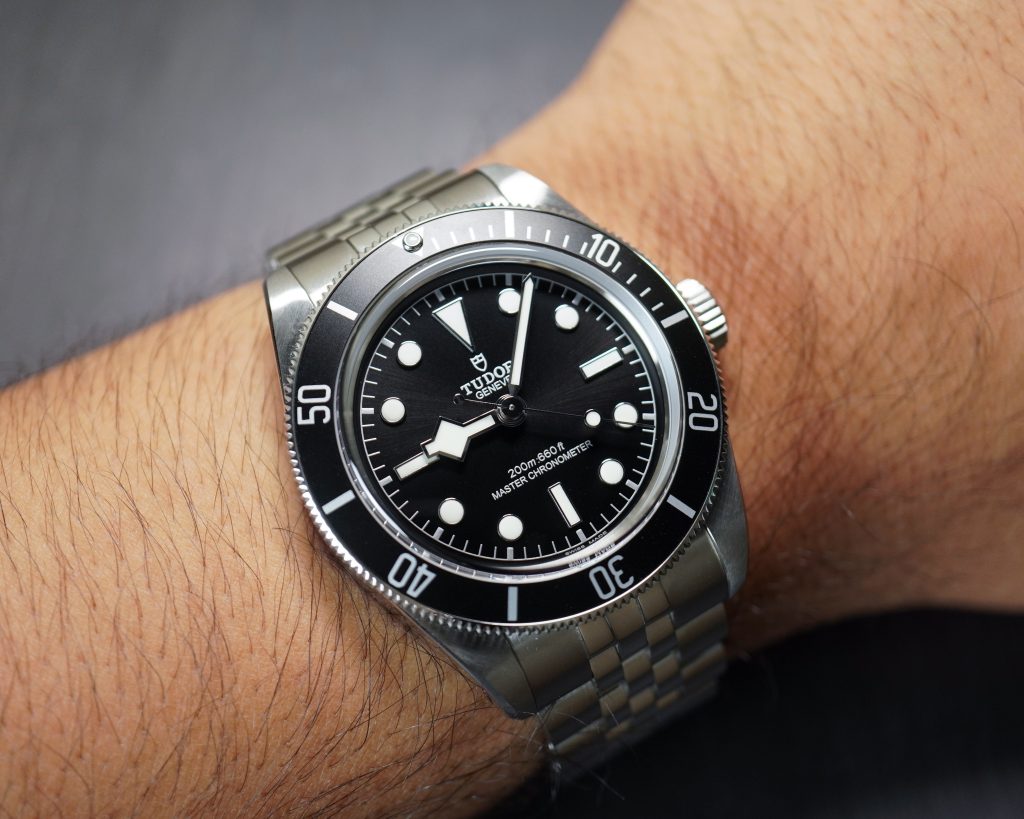

Interestingly, despite the Monochrome weighing 148 grams and the Batgirl weighing slightly less at 140 grams (both sized for my approximately 6.75″ wrist), the Tudor feels notably heavier. This perception of weight is largely attributable to how each watch distributes its weight across the watch head, bracelet, and clasp. The Batgirl achieves a more even distribution, leading to a balanced feel that comfortably hugs the wrist. In contrast, the Monochrome’s weight distribution is less balanced; its relatively lighter bracelet compared to its case causes the watch to feel top-heavy at times. Although I had the opportunity to try the Monochrome with the riveted oyster style bracelet, which offered a more balanced wearing experience than the Tubilee bracelet, the Batgirl still excels in overall wear-ability.
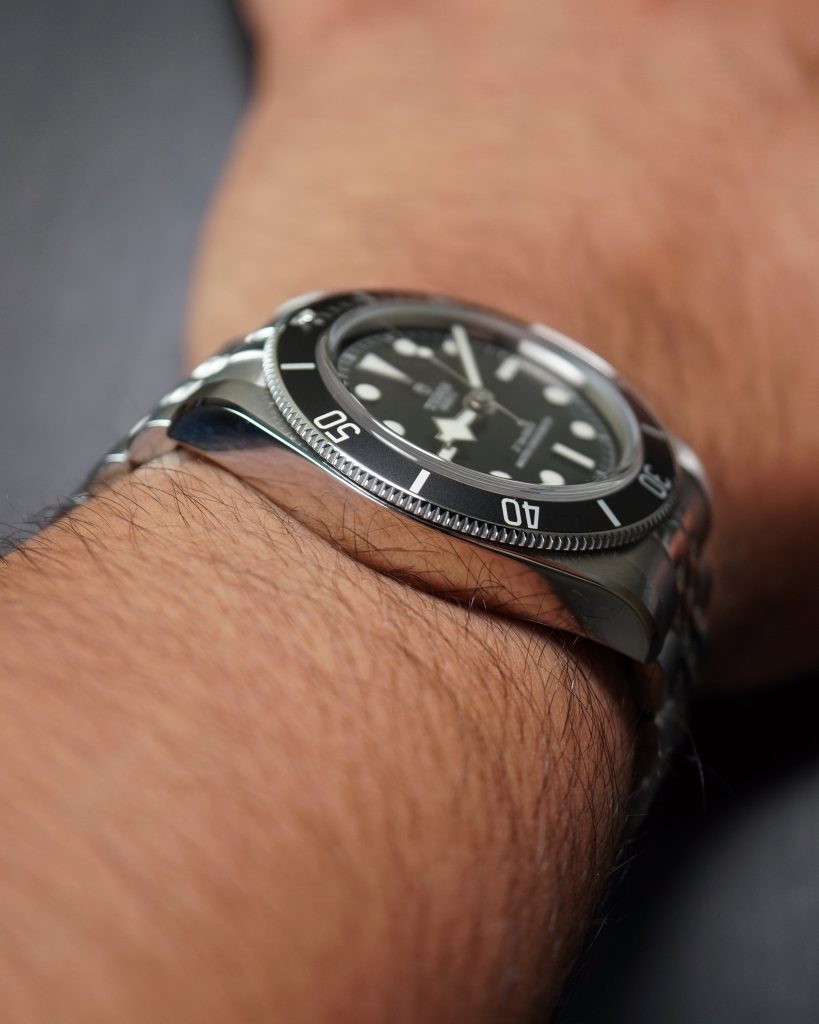

Bracelet
When comparing the bracelets of the Tudor and the Rolex, particularly in how they stack up against their price points, the Tudor impressively holds its own. Despite the Rolex’s use of 904L steel, which offers slightly greater brightness and lustre when polished, the Tudor’s 316L steel bracelet maintains a comparable level of quality in both brushed and polished finishes. This similarity is commendable given the significant price difference between the two watches. In terms of design, while both bracelets share a familiar aesthetic, there are subtle yet notable differences. The Rolex Batgirl features shorter end links with spring bars attached to the bracelet, whereas the Tudor incorporates a single female end link that offers slightly more flexibility in fit with floating spring bars. The Batgirl’s links have a semi-circular side profile with flat brushed backs, contrasting with the Tudor’s uniformly shaped links that maintain an oval profile.


The clasps on both bracelets share a similar design, yet the Tudor’s ceramic ball bearing closure feels a bit less stable compared to Rolex’s more solid spring loaded foldover mechanism. However, the Tudor’s T-Fit adjustment system is notably superior in providing a consistently tailored fit, which I find to be more practical and flexible than the Rolex’s easylink system. Although the easylink offers quick adjustments, it doesn’t match the refinement or utility of newer mechanisms available in the market (like the Brogioli SA manufactured clasps you can find on H. Moser & Cie, Glashutte Original, A. Lange & Sohne, IWC, etc.).


Overall, Tudor has made significant strides in bracelet design, coming very close to matching Rolex’s renowned attention to detail. Every surface and edge of the Rolex bracelet exudes a premium feel, a standard that Tudor has previously struggled to meet. However, the Monochrome’s bracelet approaches this standard closely, with smooth edges and a high-quality finish that are commendable. Aside from a few minor sharp edges, such as the shield on the clasp, Tudor’s effort in refining the tactile experience of their bracelet is evident and appreciable.
Wrapping Up
There are a lot of areas where these two watches go neck and neck in specifications and quality, there are many areas where the Tudor comes very close, and there are a few areas where the Tudor still lags behind (like case finishing, proportions and overall balance on wrist). If you were to evaluate these two products in a vacuum, away from the brand prestige and brand baggage that they both carry (Rolex more than Tudor), you’d likely arrive at the conclusion that the Rolex is a more premium product, because it is. But in that vacuum if you were to ask the question, “By how much do these two watches differ in price?”, I don’t think you’d get anywhere close to the 2x price increase for the Rolex over the Tudor – and that is if you look at retail prices! If you look at secondary market prices for both watches, that chasm widens to nearly 3x of a price difference.
But Rolex is a behemoth of a brand – the world’s greatest exercise in marketing, and product curation. They’ve spent decades building a reputation that allows them the luxury of being able to price things however they wish – and still have people clamoring for them. And as much as I don’t like the process of purchasing a Rolex, I think they’ve earned their ability dictate terms of purchase, by building consistently good watches for so long. But their transition from producing functional tool watches to embracing a role within luxury and high horology may alienate some purists who treasured the brand’s original utilitarian philosophy.
And while Rolex continues to bask in the glory of their relatively plateaued product evolution cycle, Tudor has been rapidly evolving, significantly enhancing its build quality, finishing, and technical capabilities. The brand has been daring, experimenting with new designs and materials, and maintaining much of the ethos that originally defined Rolex. This progression suggests that Tudor is not only capturing the essence of Rolex’s earlier ethos, but is also advancing at a pace that might one day see them reach parity in terms of quality, albeit under a different brand name. That day isn’t today, but it won’t be too long.

